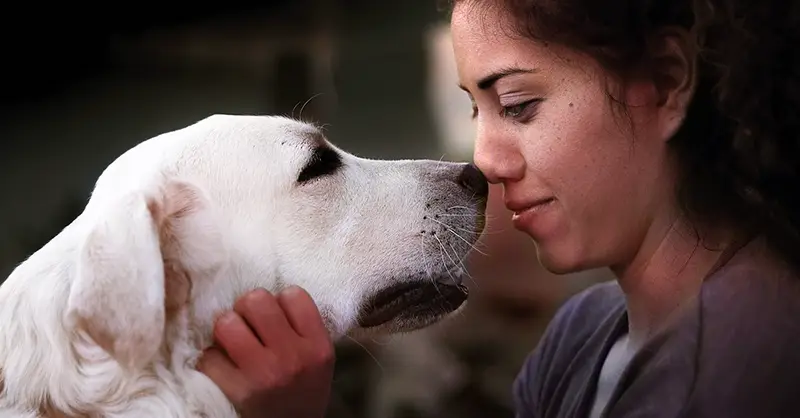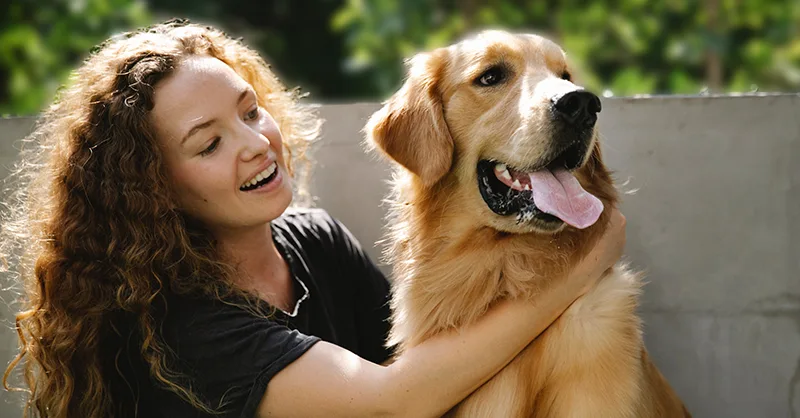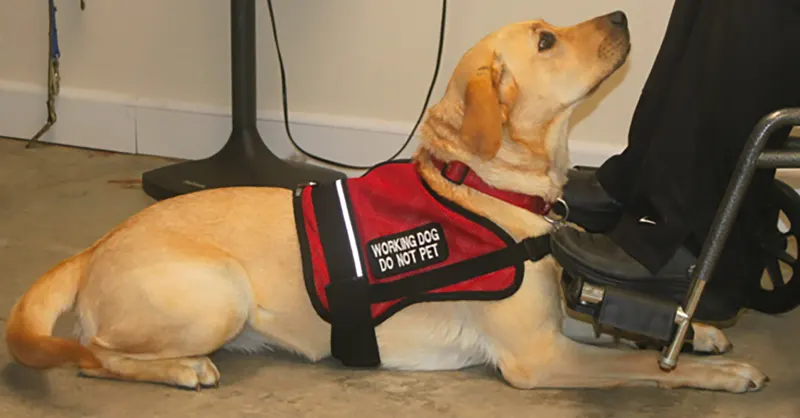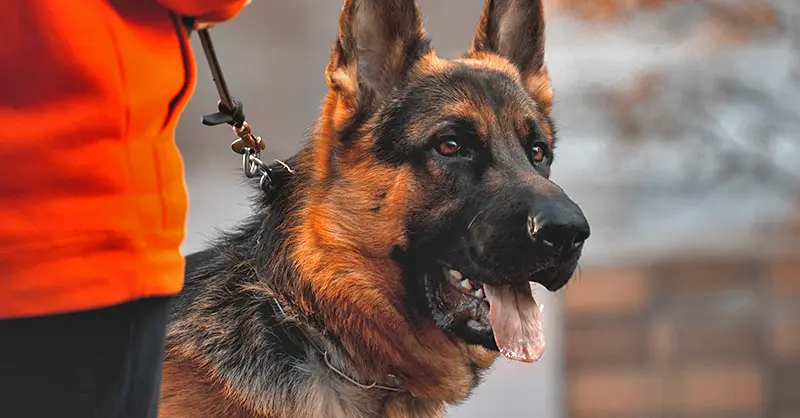Archive for the ‘Dogs’ Category
For people with mobility issues, a service dog can provide life-changing help. This assistance animal will help with daily tasks, like retrieving items, helping with balance, or opening doors in public places that would otherwise be of great difficulty for people with mobility issues. A service dog that is specialized in mobility issues suffered by their handler is called a mobility service dog.
What is a Mobility Service Dog?Service dogs, in general, perform many functions for individuals with disabilities. Some help people with visual impairments get around, while others provide psychological support for people with anxiety or other conditions. A mobility service dog can help you maintain your independence by helping with tasks that may be difficult for you to complete on your own.
For example, if you use a wheelchair or powerchair, you may have difficulty reaching items higher up in your home or items you’ve dropped on the floor. A mobility assistance dog can get these items for you. Because they’re trained to support your movement, whether you’re using a wheelchair, a walker, or a cane, they can help with various other tasks in the home. Your mobility service dog can turn lights on and off, open and close doors and cabinets, and find others in the house when you need more complex help.
Here are some jobs a mobility service dog may be able to help you with:
Support when you’re dressing and undressing Giving support/stability while walking and using stairs Fetching a phone Hitting elevator buttons Opening and closing doors and drawers Hitting automatic door openers Carrying bags and small objectsMobility assistance dogs can also help you use public transportation, like planes, trains, or buses. After a service dog is thoroughly trained and has passed a public access test, they can accompany you into any public place where other animals usually are not allowed to go.
Who Might Benefit From a Mobility Assistance Dog?Service dogs may be helpful for people with a variety of mobility challenges. Under current laws, a person requesting a mobility service dog must have a developmental, physical, or psychiatric disability that affects ambulation, mobility, or maneuverability.
This can include difficulty maintaining your balance, walking from one place to the next, requiring medical assistance during emergencies, and other difficulties getting around or performing everyday tasks.
Conditions that a mobility service dog may be able to help you with include, but are not limited to:
Brain injury Arthritis Cerebral palsy Coordination issues Fibromyalgia Gait difficulties Balance issues Multiple sclerosis Muscular dystrophy Neurological disorder Spina bifida Heart problems Spinal cord injury VertigoIn general, any condition that makes it hard for you to continue to live independently may allow you to work with a mobility service dog. These dogs are very versatile and can help with various situations. For example, a support dog can assist you if you have prosthetics or use assistive devices like a wheelchair, powerchair, cane, walker, crutches, or braces.
If you need help with balancing, standing up, moving around, retrieving items, interacting with people and the environment, monitoring medical alerts, or communicating in emergency situations, you may benefit from a mobility service dog.
ServiceDogCertifications.com
What Breed of Dog Makes a Good Mobility Service Dog?Most dog breeds can be trained to be service dogs, but you’ll probably want to choose a medium to a large dog who can reasonably perform all the tasks you need. For example, you’ll want a dog who can reach doors that need opening.
Below is a selection of dog breeds with the size and temperament to make great mobility service dogs:
Golden Retriever – These large dogs can brace a disabled person, are easy to train, and have the right temperament. Labrador Retriever – Like the Golden Retriever, Labrador Retrievers have the perfect size and temperament for mobility-challenged individuals. German Shepherd – Protective and alert, these dogs are also smart as a whip. Standard Poodle – Poodles are intelligent, have the right size, and do not shed, which is perfect for those with allergies Great Dane – These extra large dogs can assist taller people with disabilities. Great Danes also make great indoor dogs. Your Mobility Service Dog is Your CompanionIt’s important to remember that with every great mobility service dog comes great responsibility for the dog. A strong bond and trust between your dog and you are paramount to making the relationship work and having the dog perform the tasks when you’re in need.
Training your dog to become the mobility service dog you need may take time and patience. And it’s crucial to never lose focus on the primary purpose of your mobility service dog when interacting with them. However, it’s also important to play with your dog and show them affection when they’re not working. This helps with bonding and also rewards the dog for all the time they spend assisting you. And since your dog is working hard for you, you’ll want to choose good quality pet food to keep them healthy.
Having a loyal, hard-working companion like a mobility service dog by your side will not only provide a lasting friendship but also improve your quality of life in ways you may not achieve by yourself.
Show everyone your mobility service dog is an important part of your life with your Service Dog ID. Get your mobility service dog registered below.Epilepsy is a group of brain disorders and is the fourth most common neurological disease in the U.S, just behind Alzheimer’s, migraines, and strokes. The unique nerve cell activity in the brain defines epilepsy, causing seizures. Seizures deeply affect a person’s life and often prevents them from living a fulfilling life. Fortunately, a seizure alert dog can predict an upcoming episode and warn its handler to take immediate precautions. How exactly a seizure alert dog jumps into action, we’ll discuss below.
How Seizures Can Harm PeopleSeizures have a wide range of symptoms: Some people may display mild shaking; others might twitch their extremities uncontrollably. Others stare blankly during an attack. Although the symptoms may be mild, they can cause significant problems if they are in the middle of an activity like driving, swimming, or working with heavy equipment.
During a seizure, people can injure themselves and cause accidents due to loss of control. And although most episodes end on their own without problems, a small percentage of seizure attacks end with injury or lasting brain damage. In extreme cases, it may even lead to life-threatening emergencies or death. According to the Epilepsy Foundation, people diagnosed with epilepsy are 1.6 to 3 times at a higher risk of dying than those without the disorder. About 1 out of 3 people who have epilepsy have to find ways to live with uncontrolled seizures because no medications are known to treat their condition.
How Seizure Alert Dogs Can HelpBecause seizures can have significant repercussions, it’s essential to be aware of when one is starting. When there’s an advanced warning, an individual can prepare for its onset and take precautions. This is where seizure alert dogs, a specific type of service dog, can make a vital difference. About fifteen percent of dogs can predict seizures 10 to 20 minutes before they occur. This crucial window of time gives individuals the opportunity to find a safe environment, obtain medical help, or take medications.
How seizure alert dogs detect impending seizures remains unconfirmed. However, research indicates that dogs may be able to predict a seizure by two methods—changes in scent and the identification of specific motor changes in the individual.
A 2019 article published in Scientific Reports found that the accuracy rate for seizure alert dogs is very high, from 67 to 100 percent. As the body changes its processes, it emits distinct odors through the bloodstream, breath, sweat, and urine. Dogs, with their highly sensitive sense of smell, can detect biological changes in humans. It’s also thought that dogs can spot small motor differences in humans before a seizure, like pupillary changes or slight tremors.
How exactly a seizure alert dog can detect upcoming attacks is unknown, but it’s an instinct given to about 15% of canines. A Seizure Alert Dog’s Natural AbilityUnlike guide dogs and mobility support dogs, seizure detection is a task that dogs can’t train to perform. Because scientists still don’t know the exact method seizure alert dogs use to detect seizures, training dogs to do so reliably isn’t possible. Dogs who can predict a seizure do so naturally.
Some trainers attempt to “teach” dogs to detect a seizure using the sweat emitted by a seizure patient. Unfortunately, this method of training is misguided. Dogs must spot the signs that occur before a seizure event, not during or after. Teaching a dog how to detect an oncoming seizure using such a method may result in low success rates.
Seizure Response Dogs Vs Seizure Alert DogSeizure response dogs are often mistaken for seizure alert dogs, but they are not the same.
Seizure response dogs assist an individual during and after a seizure, but they don’t predict one. These dogs can assist by placing the person in a position that helps them breathe better. These dogs can also get help, guide the person to a preset safe location, or help them regain their balance.
Because supporting people through and after seizures is crucial, service dogs that can detect seizures are often also trained to be seizure response dogs. When dogs perform both tasks, as seizure alert and a seizure response dog, they are called “seizure dogs.”
Becoming a Seizure Alert DogInterestingly, service dogs who received training as seizure response dogs may develop the ability to perform seizure detection. This innate ability may form after six months working as an individual’s seizure response dog. Perhaps repeated exposure to the seizure experience fosters the natural ability to detect seizures in many response dogs.
Seizure alert dogs are an example of how much humans still don’t know about canine abilities. Though dogs have evolved alongside humans for thousands of years as our domesticated best friends, we have yet to uncover all the ways dogs can help humans. From helping serve as psychiatric service dogs to detecting seizures, canines are tremendous assets to humans.
Once you have a fully trained service dog that can detect seizures, registering or certifying your service dog is an optional step. Registrations, certifications and ID cards are helpful accessories service dog owners use for day to day life.
However, no third party can demand these items as a condition to accepting a service dog. They also do not act in lieu of proper verification. To verify someone has a seizure alert dog, third parties are allowed to ask two questions under ADA rules: 1. Is the dog required because of a disability? and 2. What work or task has the dog been trained to perform?
Almost 40% of U.S. households own a dog, and an average of $253 is spent each year on veterinary costs to keep family dogs in good health. This love for dogs isn’t surprising because dogs have been intertwined with human life for the last 11 000 years. Dogs are human’s oldest companions, hunting alongside us and saving our lives for millennia. Today, dogs don’t serve as our hunting partners as much as they used to, but they still work to assist us in other ways. And among the most hard-working dogs are trained service dogs. Below we’ll list the five different types of service dogs that may be at your service.
What Are Service DogsAccording to the Americans with Disabilities Act (ADA), a service animal is a dog that receives special training to execute a task that a person with a disability would not be able to do for themselves. For example, service dogs can guide vision impaired people, detect impending seizures, or obtain life-saving medication during an emergency. Service dogs are much more than a pet or a therapy animal. They quite literally work to save our lives.
Five Types of Service Dogs Cardiac Service Dogs Mobility Service Dogs Allergy Detection Service Dogs Psychiatric Service Dogs Guide Dogs 1. Cardiac Service DogsThrough the sense of smell, trained cardiac service dogs can recognize dangerous changes in a person’s heart rate or blood pressure. They alert people with heart problems to take immediate interventions far quicker than people can identify the changes themselves. Although they can’t perform cardiopulmonary resuscitation (CPR), cardiac service dogs can receive training to notify emergency services. They can also obtain life-saving medication if their owner becomes disoriented or unconscious.
2. Mobility Service DogsMobily service dogs do more than fetch items for their owners; they can help their owners navigate the world without falling or hurting themselves. Trained to assist people who struggle with mobility issues (like difficulty walking, paralysis, or prone to falling), mobility service dogs specifically assist their handlers’ needs.
A mobility service dog can receive training to perform various tasks, like picking up dropped items, removing small obstacles from a person’s path, or act as a brace for people with balance problems. Mobility service dogs also receive training to obtain objects for their handler, keeping their handler sitting and minimizing the chances of their handler falling. When used as a brace, mobility service dogs tend to be large-sized breeds because they must be large enough to bear at least a portion of their owner’s weight.
Service dogs come in different types and sizes to specifically assist with the owner’s physical or mental disorder. 3. Allergy Detection Service DogsAllergen detection service dogs use their keen sense of smell to save human lives. If enough of an allergen is present, an allergen detection service dog can recognize the scent and alert its handler to the danger. For example, a person with a severe peanut allergy might be served a piece of cake without peanuts but cut with a knife previously used to cut a peanut-containing dessert. An allergen detection service dog can spot the smell of a peanut, even if it’s weak, and alert its owner it’st its presence.
It is important to note that allergen detection service dogs aren’t on the lookout for substances but odors. If a substance is present but has no odor, the service dog may not identify the allergen.
4. Psychiatric Service DogsPsychiatric service dogs are not emotional support animals or therapy dogs. These are legitimate service dogs and perform a specific task to alleviate their handler’s psychiatric disorder. Psychiatric service dogs are trained to sense a change in their owner and provide an intervention that assists their handler with their emotions. Psychiatric service dogs also receive training to identify triggers that can increase their handler’s agitation or anger and steer their handler away from such situations.
People who suffer from auditory or visual hallucinations can also benefit from a psychiatric service dog. The dog can obtain training to help identify if a third individual is present or is a mere hallucination. Psychiatric service dogs can also guide their handler home or to safety if the owner becomes confused. A psychiatric disorder can be frightening; therefore, psychiatric service dogs provide a layer of support and assistance at all times.
Examples of psychiatric service dog tasks. Wonder if your emotional disorder qualifies for a psychiatric service dog? Get an assessment by a licensed health professional. 5. Guide DogsService dogs for the visually impaired, or guide dogs, are the most well-known type of service dogs. It’s relatively easy to spot this type of service dog because they wear a special harness that distributes pressure in a specific way, enabling a guide dog’s handler and the dog to communicate with each other quickly. For example, crossing a busy, noisy street can be exceptionally dangerous for the vision impaired. A guide dog with a harness allows the dog to pull and tell its handler when to proceed and stop.
Unlike most other service dogs, guide dogs are trained for “intelligent disobedience,” meaning that they can go against or ignore their handler’s instructions if the situation is dangerous. They receive training to identify hazards or conditions that can jeopardize safety.
A Service Dog For All NeedsService dogs can assist owners in overcoming any physical or mental disability. However, choosing the right dog for the job is paramount to a service dog’s successful training. But whatever your needs may be, any one of the different types of service dogs can help you live a more fulfilled and happy life.







